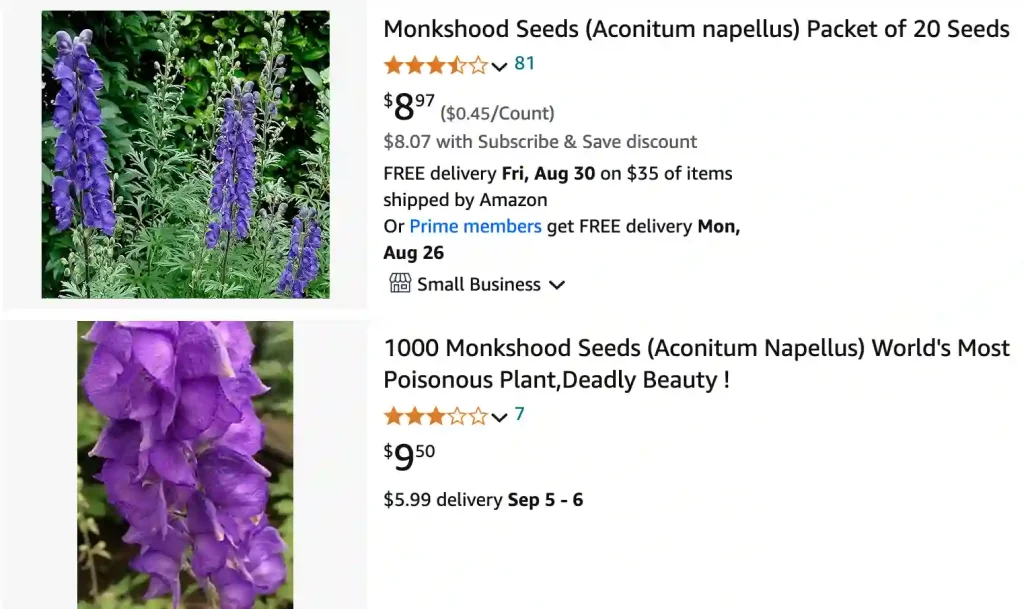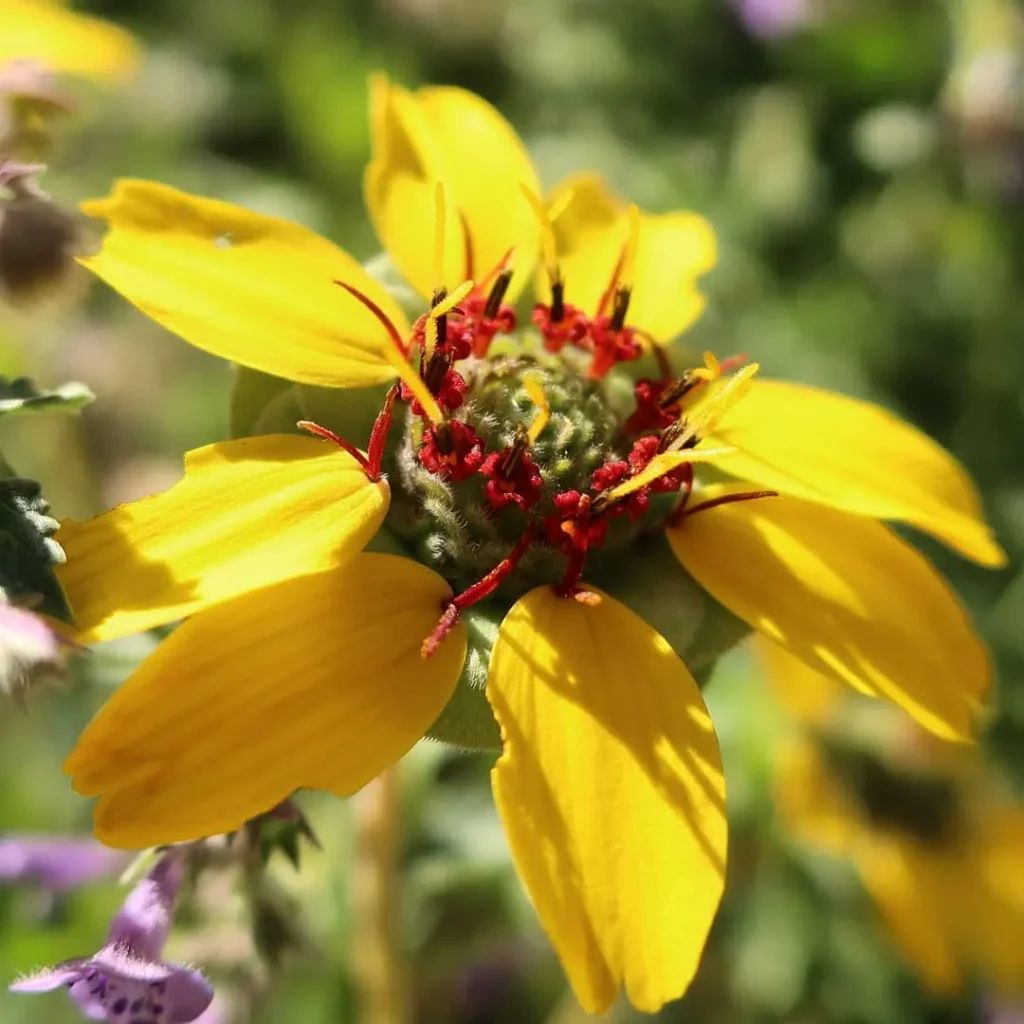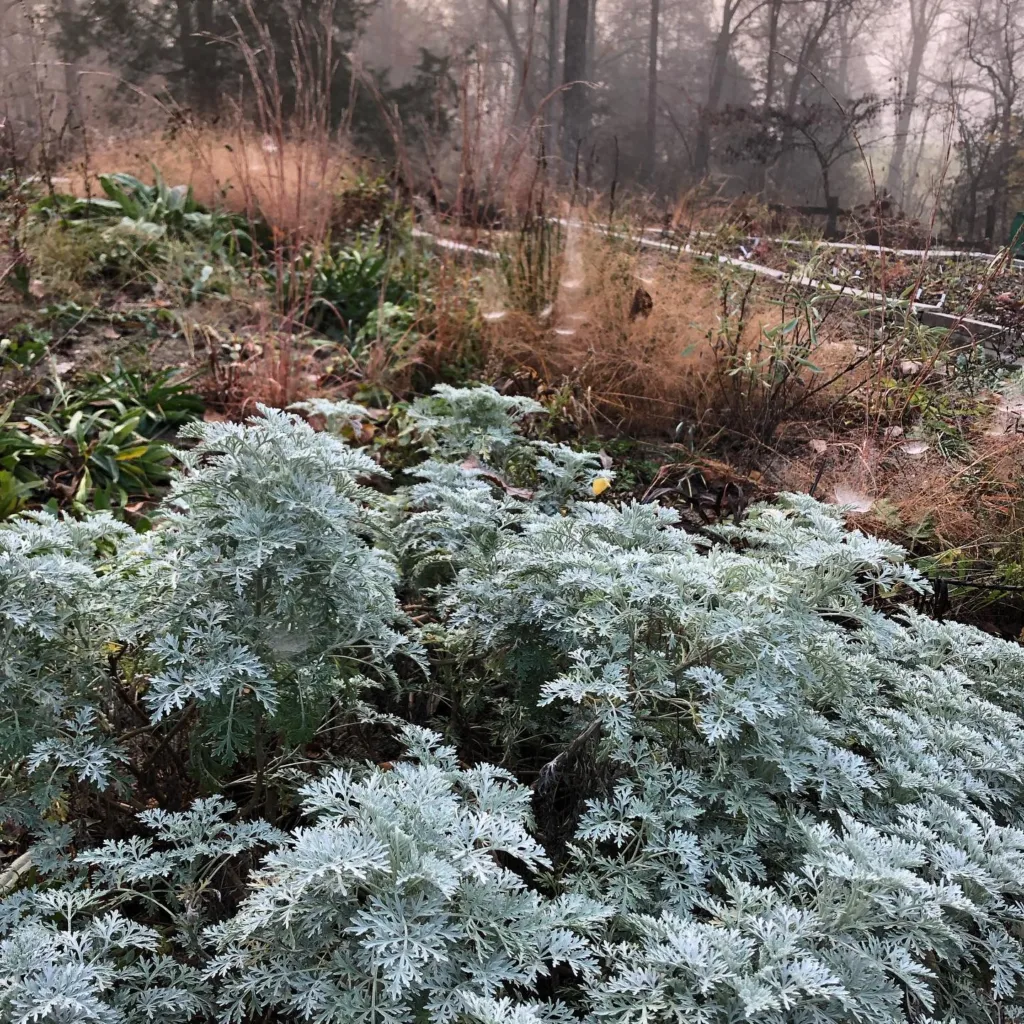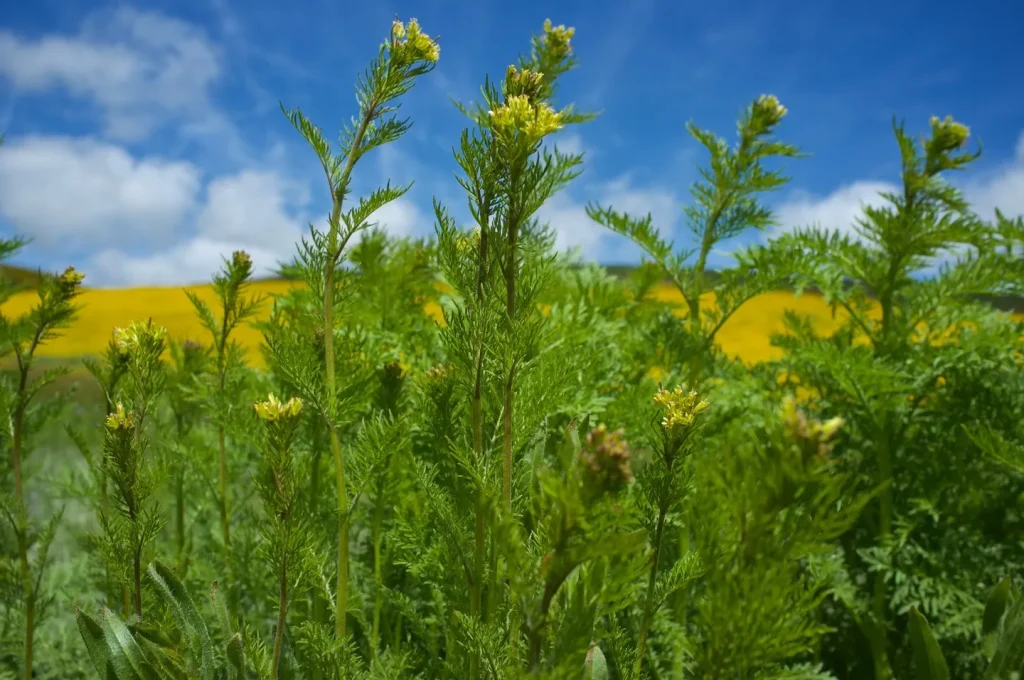
September 26 – Aconitum
"Aconitum, the monkshood, represents September 26."
Aconitum symbolizes mystery and protection. You are deeply intuitive and offer strength to those in need. Like its hooded blooms, your allure is captivating.
FAQs About Monkshood
As a garden enthusiast, I’ve come across Monkshood in various discussions and gardening forums. If you’re curious about this intriguing plant, you’ve come to the right place. Let’s dive into the common questions and everything you need to know about Monkshood.
What is Monkshood?
Monkshood, scientifically known as Aconitum, belong to the Ranunculaceae, family is a perennial plant famous for its striking appearance and toxicity. It’s also commonly referred to as Wolf’s Bane. The plant is known for its unique helmet-shaped flowers, which can range in color from deep blue to purple. Monkshood thrives in cooler climates and is often found in woodland gardens or shaded areas.
Aconitum species
- Aconitum abietetorum W.T.Wang & L.Q.Li
- Aconitum × acuminatum Rchb.
- Aconitum acutiusculum H.R.Fletcher & Lauener
- Aconitum × acutum Rchb.
- Aconitum ajanense Steinb.
- Aconitum alboflavidum W.T.Wang
- Aconitum alboviolaceum Kom.
- Aconitum alpinonepalense Tamura
- Aconitum ambiguum Rchb.
- Aconitum amplexicaule Lauener
- Aconitum anglicum Stapf
- Aconitum angulatum Tamura
- Aconitum angusticassidatum Steinb.
- Aconitum angustifolium Bernh. ex Rchb.
- Aconitum anhuiense Lu Q.Huang, H.S.Peng & M.Z.Yin
- Aconitum anthora L.
- Aconitum apetalum (Huth) B.Fedtsch.
- Aconitum aquilonare A.Kern. ex Gáyer
- Aconitum aradanicum Stepanov
- Aconitum artemisiifolium A.I.Baranov & Skvortsov
- Aconitum arunii P.Agnihotri, D.Husain & T.Husain
- Aconitum asahikawaense Kadota
- Aconitum assamicum Lauener
- Aconitum × austriacum Mucher
- Aconitum austrokoreense Koidz.
- Aconitum axilliflorum Vorosch.
- Aconitum azumiense Kadota & Hashido
- Aconitum baburinii (Vorosch.) Schlotgauer
- Aconitum baicalense (Regel) Turcz. ex Rapaics
- Aconitum bailangense Y.Z.Zhao
- Aconitum barbatum Patrin ex Pers.
- Aconitum × bartokianum Starm.
- Aconitum basitruncatum W.T.Wang
- Aconitum × baumgartenianum Simonk.
- Aconitum × bavaricum Starm.
- Aconitum × berdaui Zapał.
- Aconitum bhedingense Lauener
- Aconitum bhutanobulbilliferum Kadota
- Aconitum biflorum Fisch. ex DC.
- Aconitum brachypodum Diels
- Aconitum bracteolatum Lauener
- Aconitum brevicalcaratum (Finet & Gagnep.) Diels
- Aconitum brevilimbum Lauener
- Aconitum brevipes (W.T.Wang) Luferov & Erst
- Aconitum brevipetalum W.T.Wang
- Aconitum brunneum Hand.-Mazz.
- Aconitum bucovinense Zapał.
- Aconitum × bujbense Stepanov
- Aconitum bulbilliferum Hand.-Mazz.
- Aconitum bulleyanum Diels
- Aconitum burnatii Gáyer
- Aconitum calthifolium H.F.Comber
- Aconitum × cammarum L.
- Aconitum campylorrhynchum Hand.-Mazz.
- Aconitum cannabifolium Franch. ex Finet & Gagnep.
- Aconitum carmichaelii Debeaux Plant FAQs: Aconitum Carmichaelii
- Aconitum castellanum (Molero & C.Blanché) Rottenst.
- Aconitum changianum W.T.Wang
- Aconitum charkeviczii Vorosch.
- Aconitum chasmanthum Stapf ex Holmes
- Aconitum chayuense W.T.Wang
- Aconitum chiachaense W.T.Wang
- Aconitum chiisanense Nakai
- Aconitum chilienshanicum W.T.Wang
- Aconitum chinense Paxton
- Aconitum chloranthum Hand.-Mazz.
- Aconitum chrysotrichum W.T.Wang
- Aconitum chuianum W.T.Wang
- Aconitum ciliare DC.
- Aconitum clusianum Rchb.
- Aconitum cochleare Vorosch.
- Aconitum columbianum Nutt.
- Aconitum consanguineum Vorosch.
- Aconitum contortum Finet & Gagnep.
- Aconitum coreanum (H.Lév.) Rapaics
- Aconitum corsicum Gáyer
- Aconitum crassiflorum Hand.-Mazz.
- Aconitum crassifolium Steinb.
- Aconitum cryptoviviparum Stepanov
- Aconitum curvipilum Riedl
- Aconitum cymbulatum (Schmalh.) Lipsky
- Aconitum daxinganlinense Y.Z.Zhao
- Aconitum decipiens Vorosch. & Anfalov
- Aconitum degenii Gáyer
- Aconitum delavayi Franch.
- Aconitum delphiniifolium DC.
- Aconitum desoulavyi Kom.
- Aconitum dhwojii Lauener
- Aconitum diqingens Q.E.Yang & Z.D.Fang
- Aconitum dissectum D.Don
- Aconitum dolichorhynchum W.T.Wang
- Aconitum dolichostachyum W.T.Wang
- Aconitum × dragulescuanum Mucher
- Aconitum duclouxii H.Lév.
- Aconitum dunhuaense S.H.Li
- Aconitum elliotii Lauener
- Aconitum elwesii Stapf
- Aconitum episcopale H.Lév.
- Aconitum × exaltatum Bernh. ex Rchb.
- Aconitum falciforme Hand.-Mazz.
- Aconitum fanjingshanicum W.T.Wang
- Aconitum ferox Wall. ex Ser.
- Aconitum finetianum Hand.-Mazz.
- Aconitum firmum Rchb.
- Aconitum fischeri Rchb.
- Aconitum flavum Hand.-Mazz.
- Aconitum flerovii Steinb.
- Aconitum fletcherianum G.Taylor
- Aconitum formosanum Tamura
- Aconitum forrestii Stapf
- Aconitum franchetii Finet & Gagnep.
- Aconitum × fudjisanense Nakai
- Aconitum fukutomei Hayata
- Aconitum funiculare Stapf
- Aconitum fusungense S.H.Li & Y.H.Huang
- Aconitum gassanense Kadota & Sh.Kato
- Aconitum × gayeri Starmuhl
- Aconitum geniculatum H.R.Fletcher & Lauener
- Aconitum georgei H.F.Comber
- Aconitum gigas H.Lév. & Vaniot
- Aconitum glabrisepalum W.T.Wang
- Aconitum glandulosum Rapaics
- Aconitum grandibracteolatum (W.T.Wang) Luferov & Erst
- Aconitum grossedentatum (Nakai) Nakai
- Aconitum gubanovii Luferov & Vorosh.
- Aconitum habaense W.T.Wang
- Aconitum × hakusanense Nakai
- Aconitum hamatipetalum W.T.Wang
- Aconitum haridasanii R.Tiwary, Harsh Singh & D.Adhikari
- Aconitum × hebegynum DC.
- Aconitum helenae Vorosch.
- Aconitum hemsleyanum E.Pritz.
- Aconitum henryi E.Pritz. ex Diels
- Aconitum heterophylloides (Brühl) Stapf
- Aconitum heterophyllum Wall. ex Royle
- Aconitum hezuoense W.T.Wang
- Aconitum hicksii Lauener
- Aconitum hiroshi-igarashii Kadota
- Aconitum hookeri Stapf
- Aconitum hopeiense (W.T.Wang) Vorosch.
- Aconitum huiliense Hand.-Mazz.
- Aconitum ichangense (Finet & Gagnep.) Hand.-Mazz.
- Aconitum iidemontanum Kadota, Kita & Ueda
- Aconitum iinumae Kadota
- Aconitum ikedae Kadota
- Aconitum incisofidum W.T.Wang
- Aconitum infectum Greene
- Aconitum iochanicum Ulbr.
- Aconitum iranshahrii Riedl
- Aconitum jaluense Kom.
- Aconitum japonicum Thunb.
- Aconitum jeholense Nakai & Kitag.
- Aconitum jenisseense Polozhij
- Aconitum jilongense W.T.Wang & L.Q.Li
- Aconitum jin-muratae Kadota & Nob.Tanaka
- Aconitum kagerpuense W.T.Wang
- Aconitum kamelinii A.A.Solovjev
- Aconitum karafutense Miyabe & Nakai
- Aconitum karakolicum Rapaics
- Aconitum kashmiricum Stapf ex Coventry
- Aconitum khanminthunii A.A.Solovjev & Shmakov
- Aconitum kirghistanicum Kadota
- Aconitum kirinense Nakai
- Aconitum kitadakense Nakai
- Aconitum kiyomiense Kadota
- Aconitum komarovianum Nakai
- Aconitum kongboense Lauener
- Aconitum korshinskyi Tzvelev
- Aconitum krasnoboroffii Kadota
- Aconitum krylovii Steinb.
- Aconitum kunasilense Nakai
- Aconitum kungshanense W.T.Wang
- Aconitum kurilense Takeda
- Aconitum kurramense Qureshi & Chaudhri
- Aconitum kurtuschibinicum Stepanov
- Aconitum kusnezoffii Rchb.
- Aconitum kuzenevae Vorosch.
- Aconitum laeve Royle
- Aconitum laevicaule W.T.Wang
- Aconitum lamarckii Rchb. ex Spreng.
- Aconitum lasianthum (Rchb.) Simonk.
- Aconitum lasiocarpum (Rchb.) Gáyer
- Aconitum lasiostomum Rchb. ex Besser
- Aconitum laxifoliatum W.T.Wang
- Aconitum legendrei Hand.-Mazz.
- Aconitum leiwuqiense W.T.Wang
- Aconitum lethale Griff.
- Aconitum leucostomum Vorosch.
- Aconitum liangshanicum W.T.Wang
- Aconitum lianhuashanicum W.T.Wang
- Aconitum liljestrandii Hand.-Mazz.
- Aconitum limprichtii Hand.-Mazz.
- Aconitum loczyanum Rapaics
- Aconitum longe-crassidatum Nakai
- Aconitum longilobum W.T.Wang
- Aconitum longipedicellatum Lauener
- Aconitum luanchuanense W.T.Wang
- Aconitum ludingense W.T.Wang
- Aconitum ludlowii Exell
- Aconitum lycoctonifolium W.T.Wang & L.Q.Li
- Aconitum lycoctonum L.
- Aconitum macrorhynchum Turcz. ex Ledeb.
- Aconitum maninense (Skalický) Mitka
- Aconitum × mariae Rottenst., Mitka & A.V.Novikov
- Aconitum martjanovii Stepanov
- Aconitum mashikense Kadota & S.Umezawa
- Aconitum maximum Pall. ex DC.
- Aconitum metajaponicum Nakai
- Aconitum milinense W.T.Wang
- Aconitum miyabei Nakai
- Aconitum moldavicum Hacq.
- Aconitum monanthum Nakai
- Aconitum monticola Steinb.
- Aconitum moschatum (Brühl) Stapf
- Aconitum nagarum Stapf
- Aconitum nakaoi Tamura
- Aconitum namlaense W.T.Wang
- Aconitum × nanum (Baumg.) Simonk.
- Aconitum napellus L. Plant FAQs: Aconitum Napellus – Aconite – Monkshood – Wolfsbane
- Aconitum naviculare (Brühl) Stapf
- Aconitum nemorum Popov
- Aconitum neosachalinense H.Lév.
- Aconitum neotortuosum Nakai
- Aconitum nevadense R.Uechtr. ex Gáyer
- Aconitum nielamuense W.T.Wang
- Aconitum nipponicum Nakai
- Aconitum noveboracense A.Gray ex Coville
- Aconitum novoaxillare W.T.Wang
- Aconitum novoluridum Munz
- Aconitum nutantiflorum P.K.Chang ex W.T.Wang
- Aconitum ochotense Rchb.
- Aconitum ohmorii Kadota
- Aconitum okuyamae Nakai
- Aconitum orientale Mill.
- Aconitum orochryseum Stapf
- Aconitum ouvrardianum Hand.-Mazz.
- Aconitum ovatum Lindl.
- Aconitum palmatum D.Don
- Aconitum paradoxum Rchb.
- Aconitum × parahakonense Nakai
- Aconitum parcifolium Q.E.Yang & Z.D.Fang
- Aconitum paskoi Vorosch.
- Aconitum pauciflorum Host
- Aconitum × pawlowskii Mitka & Starm.
- Aconitum pendulicarpum P.K.Chang ex W.T.Wang
- Aconitum pendulum N.Busch
- Aconitum pentheri Hayek
- Aconitum phyllostegium Hand.-Mazz.
- Aconitum piepunense Hand.-Mazz.
- Aconitum pilipes (Rchb.) Gáyer
- Aconitum pilopetalum W.T.Wang & L.Q.Li
- Aconitum × pilosiusculum (Ser.) Jacques
- Aconitum plicatum Köhler ex Rchb.
- Aconitum poluninii Lauener
- Aconitum polycarpum P.K.Chang ex W.T.Wang
- Aconitum polyschistum Hand.-Mazz.
- Aconitum pomeense W.T.Wang
- Aconitum popovii Steinb. & Schischk. ex Siplivinskii
- Aconitum potaninii Kom.
- Aconitum productum Rchb.
- Aconitum prominens Lauener
- Aconitum pseudobrunneum W.T.Wang
- Aconitum pseudodivaricatum W.T.Wang
- Aconitum pseudokongboense W.T.Wang & L.Q.Li
- Aconitum pseudokusnezowii Vorosch.
- Aconitum pseudolaeve Nakai
- Aconitum pseudostapfianum W.T.Wang
- Aconitum pterocaule Koidz.
- Aconitum pteropus Nakai
- Aconitum puchonroenicum Uyeki & Sakata
- Aconitum pulchellum Hand.-Mazz.
- Aconitum quelpaertense Nakai
- Aconitum racemulosum Franch.
- Aconitum raddeanum Regel
- Aconitum ramulosum W.T.Wang
- Aconitum ranunculoides Turcz.
- Aconitum reclinatum A.Gray
- Aconitum refracticarpum P.K.Chang ex W.T.Wang
- Aconitum refractum (Finet & Gagnep.) Hand.-Mazz.
- Aconitum rhombifolium F.H.Chen
- Aconitum richardsonianum Lauener
- Aconitum rilongense Kadota
- Aconitum rockii H.R.Fletcher & Lauener
- Aconitum × ronnigeri Gáyer
- Aconitum rotundifolium Kar. & Kir.
- Aconitum rotundocassideum W.T.Wang
- Aconitum rubicundum (Ser.) Fisch. ex C.Young, J.Young & P.Young
- Aconitum sachalinense F.Schmidt
- Aconitum sajanense Kuminova
- Aconitum sanyoense Nakai
- Aconitum scaposum Franch.
- Aconitum × schneebergense Gáyer
- Aconitum sczukinii Turcz.
- Aconitum secundiflorum W.T.Wang
- Aconitum senanense Nakai
- Aconitum septentrionale Koelle
- Aconitum seravschanicum Steinb.
- Aconitum × setosum Grinţ.
- Aconitum shennongjiaense Q.Gao & Q.E.Yang
- Aconitum sherriffii Lauener
- Aconitum sikkimensis Harsh Singh, A.Pradhan & D.Adhikari
- Aconitum sinchiangense W.T.Wang
- Aconitum sinoaxillare W.T.Wang
- Aconitum sinomontanum Nakai
- Aconitum smithii Ulbr. ex Hand.-Mazz.
- Aconitum soongaricum (Regel) Stapf
- Aconitum souliei Finet & Gagnep.
- Aconitum soyaense Kadota
- Aconitum spathulatum W.T.Wang
- Aconitum spiripetalum Hand.-Mazz.
- Aconitum staintonii Lauener
- Aconitum stapfianum Hand.-Mazz.
- Aconitum stoloniferum Vorosch.
- Aconitum stramineiflorum P.K.Chang ex W.T.Wang
- Aconitum stylosoides W.T.Wang
- Aconitum stylosum Stapf
- Aconitum subglandulosum Khokhr.
- Aconitum sukaczevii Steinb.
- Aconitum superbum Fritsch
- Aconitum × suspensum Nakai
- Aconitum swatense Tamura
- Aconitum tabatae Tamura
- Aconitum taigicola Vorosch.
- Aconitum taipeicum Hand.-Mazz.
- Aconitum talassicum Popov
- Aconitum tangense Marquand & Airy Shaw
- Aconitum tanguticum (Maxim.) Stapf
- Aconitum tanzybeicum Stepanov
- Aconitum taronense (Hand.-Mazz.) H.R.Fletcher & Lauener
- Aconitum tatsienense Finet & Gagnep.
- Aconitum tauricum Wulfen
- Aconitum tawangense R.Tiwary, Harsh Singh & D.Adhikari
- Aconitum tenue Rydb.
- Aconitum tenuicaule W.T.Wang
- Aconitum tenuigaleatum W.T.Wang
- Aconitum × teppneri Mucher ex Starm.
- Aconitum tongolense Ulbr.
- Aconitum toxicum Rchb.
- Aconitum transsectum Diels
- Aconitum trisectum (W.T.Wang & L.Q.Li) Luferov & Erst
- Aconitum × triste Gáyer
- Aconitum tsaii W.T.Wang
- Aconitum tsariense Lauener
- Aconitum tuoliense W.T.Wang
- Aconitum turczaninowii Vorosch.
- Aconitum umbrosum (Korsh.) Kom.
- Aconitum umezawae Kadota
- Aconitum uncinatum L.
- Aconitum urumqiense Z.Z.Yang
- Aconitum variegatum L.
- Aconitum vilmorinianum Kom.
- Aconitum violaceum Jacquem. ex Stapf
- Aconitum vitosanum Gáyer
- Aconitum vivantii Rottenst.
- Aconitum volubile Pall. ex Koelle
- Aconitum vulparia Rchb.
- Aconitum wajimanum Kadota
- Aconitum wangyedianense Y.Z.Zhao
- Aconitum williamsii Lauener
- Aconitum woroschilowii Luferov
- Aconitum wuchagouense Y.Z.Zhao
- Aconitum wulingense Nakai
- Aconitum wumengense J.He & E.D.Liu
- Aconitum yamazakii Tamura & Namba
- Aconitum yangii W.T.Wang & L.Q.Li
- Aconitum yinschanicum Y.Z.Zhao
- Aconitum yunlingense Q.E.Yang & Z.D.Fang
- Aconitum yuparense Takeda
- Aconitum zigzag H.Lév. & Vaniot
What Does Monkshood Look Like?
Monkshood’s most distinguishing feature is its helmet-shaped flowers. These blooms resemble a monk’s hood, giving the plant its name. The flowers grow in tall spikes and can be blue, purple, or white. The foliage consists of deeply lobed, dark green leaves that add to the plant’s ornamental appeal. Monkshood can reach heights of up to 4 feet, making it a striking addition to any garden.
Is Monkshood Poisonous?
Yes, Monkshood is highly poisonous. Every part of the plant, including the leaves, stems, and flowers, contains toxic alkaloids that can be harmful if ingested. The toxins can cause severe reactions, including nausea, vomiting, and even heart arrhythmias. If you have children or pets, it’s essential to be cautious and avoid planting Monkshood in areas where they might come into contact with it.
When Does Monkshood Bloom?
Monkshood typically blooms in late summer to early fall, from August to October. The flowering period can vary slightly depending on your climate and the specific variety of Monkshood you have. During this time, the plant produces its unique helmet-shaped flowers, adding a touch of color to your garden.
Does Monkshood Spread?
Monkshood can spread, but it’s generally not as aggressive as some other perennials. It grows from a rhizome system, which allows it to slowly expand over time. If left unchecked, Monkshood can form dense clumps. However, it’s not known for spreading rapidly or becoming invasive. Regular maintenance and division can help manage its growth.
How to Get Rid of Monkshood?
If you need to remove Monkshood from your garden, it’s important to handle it with care due to its toxicity. Wear gloves and avoid touching your face. To remove the plant, dig up the entire root system, ensuring you get all the rhizomes. Dispose of the plant materials properly to prevent accidental contact. Regular monitoring and removal of new growth can help keep Monkshood under control.
How to Care for Monkshood?
Caring for Monkshood involves a few key practices. It prefers well-drained soil and partial to full shade, making it ideal for woodland gardens. Ensure the soil remains consistently moist but not waterlogged. Monkshood is relatively low-maintenance but benefits from annual mulching to retain moisture and suppress weeds. Deadhead spent flowers to encourage a neat appearance and prevent self-seeding.
How to Propagate Monkshood?
Monkshood can be propagated by dividing the rhizomes in early spring or fall. Carefully dig up the plant and separate the rhizomes, ensuring each division has roots and buds. Replant the divisions immediately in well-prepared soil. You can also start Monkshood from seeds, but this method requires patience and a bit more attention to detail.
What is Monkshood Used For?
Historically, Monkshood has been used in traditional medicine for its analgesic and anti-inflammatory properties. However, due to its toxicity, it is no longer used in modern medicine. The plant’s primary use today is ornamental, valued for its dramatic flowers and unique appearance in garden settings.
Where to Buy Monkshood?
Monkshood can be purchased from specialty nurseries, garden centers, or online plant retailers. When buying, ensure you choose a reputable source to get healthy, true-to-name plants. It’s also a good idea to check local regulations, as Monkshood’s toxicity may limit its sale in some areas.
Monkshood vs Wolfsbane
Monkshood and Wolfsbane are actually the same plant, Aconitum. The terms are used interchangeably, with Wolfsbane being another common name for Monkshood. Both refer to the same plant with its characteristic helmet-shaped flowers and toxic properties.
Monkshood vs Delphinium
While Monkshood and Delphinium may look similar due to their tall spikes of flowers, they are different species. Monkshood has helmet-shaped blooms and is highly toxic, whereas Delphinium’s flowers are often more tubular and less toxic. Both plants can add a splash of color to your garden, but their care and toxicity differ.
Monkshood vs Belladonna
Monkshood and Belladonna are often confused due to their toxic properties. However, they belong to different plant families. Monkshood is from the Ranunculaceae family, while Belladonna, or Deadly Nightshade, belongs to the Solanaceae family. Both are poisonous, but Belladonna is generally more toxic and has different medicinal uses and plant characteristics.
Monkshood vs Foxglove
Monkshood and Foxglove can be mistaken for each other because of their tall flower spikes. However, Foxglove (Digitalis) has tubular flowers and is used in medicine for its cardiac properties, whereas Monkshood (Aconitum) has helmet-shaped blooms and is primarily ornamental. Both plants are toxic, but their toxicity levels and uses vary.
Monkshood vs Lupine
Lupine and Monkshood are both attractive garden plants, but they have different features. Lupines have pea-like flowers and are part of the Fabaceae family, while Monkshood has helmet-shaped flowers and belongs to the Ranunculaceae family. Lupines are generally not as toxic as Monkshood and are often used for their nitrogen-fixing abilities in soil.
Monkshood vs Spiderwort
Spiderwort, or Tradescantia, and Monkshood are quite different. Spiderwort is known for its grass-like leaves and colorful, three-petaled flowers, while Monkshood is recognized for its tall, helmet-shaped blooms and toxic nature. Spiderwort is non-toxic and often used as a ground cover or in borders, contrasting sharply with Monkshood’s ornamental and hazardous characteristics.
Conclusion
Monkshood is a fascinating plant with a range of uses and characteristics. Its striking appearance and toxic nature make it both a beautiful and potentially dangerous addition to your garden. Understanding how to care for, propagate, and manage Monkshood can help you make the most of this unique plant while ensuring safety for you and your garden companions. Whether you’re drawn to its dramatic flowers or simply want to learn more, Monkshood offers plenty to explore.
If i die, water my plants!



